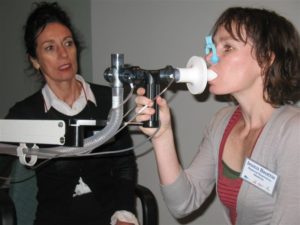Member 1= 316200mL per day.
Member 2 = 280800mL per day.
Member 3= 302400mL per day.
316200+280800+302400/3=899400/3=299800mL
On average our group takes in 299800mL of air per day.
If I had just been working out before the lab then my breathing rate would be faster because my body would require more oxygen to meet my ATP consumption and ensure the continuation of aerobic cellular respiration. The effects of exercise would show up in oxygen absorbed in one day, the volume of breath taken in, the volume of breath, and percent of oxygen absorbed.
The breathing rate will be different depending on height. This is because a taller individual will require more oxygen to “feed” the potentially large quantity of red blood cells which will have to travel greater distances. Therefore they will require more inhales/ exhales to increase gas exchange.
Physical fitness will change breathe rate because a more physically fit person’s lungs and heart will work more efficiently. Therefore their lungs will be able to absorb and a greater percentage of oxygen and therefore not have to inhale/ exhale as much as someone who is less physically fit.
Chest volume/ development also affects your breathing rate. A larger chest volume could potentially lead to larger and more developed lungs which can hold larger quantities of oxygen and perform higher rates of gas exchange.
Low Air Pressure; by reducing the number of oxygen atoms in the air, the lungs will have to work harder. Because the lungs rely on diffusion in order to inhale/ exhale by disturbing that balance, you will have to use greater force and faster breathing rates in order to compensate and maintain homeostasis.
6 billion people use up 1.7988^15 mL of oxygen per day. The Earth will never run out of oxygen for a variety of reasons. Oxygen is being made, converted, or produced by many processes, everywhere, all the time. One of the biggest producers of oxygen is plants, both in the oceans and on land. Plants take in carbon dioxide, and during the photosynthesis process, “breathe out” oxygen.
Vital capacity is a term that refers to the maximum volume someone can breathe in his/her lungs (the max volume of air inhaled after a max exhalation). It depends on many factors.
1) Physical Fitness- This will allow for individuals with more developed and efficient lungs to inhale larger quantities of air and absorb more oxygen.
2) Chronic Lung Complications (i.e Bronchitis, Lung Cancer etc.)- This can cause inflammation of bronchial tubes which constricts and resists the flow of air in and out of the lungs.
3) Obesity- Weight complications can increase pressure on intercostals muscles which will restrict against inhalations.
4) Height- Taller individuals will have larger chest cavities in which they can inhale and exhale larger air quantities.
5) The posture of the body (When someone lies down their vital capacity is less than standing)- Because your body requires more oxygen standing up, more air will be required during inhalations and exhalations. Whereas lying down, which requires less oxygen will allow for decreased inhalations and exhalations.


1 Comment